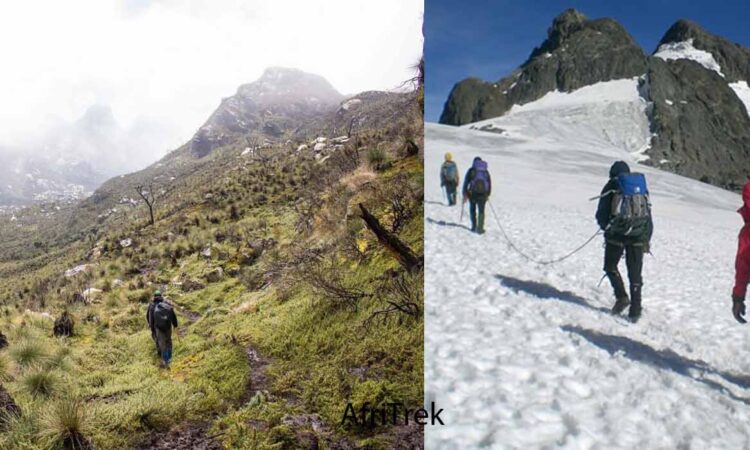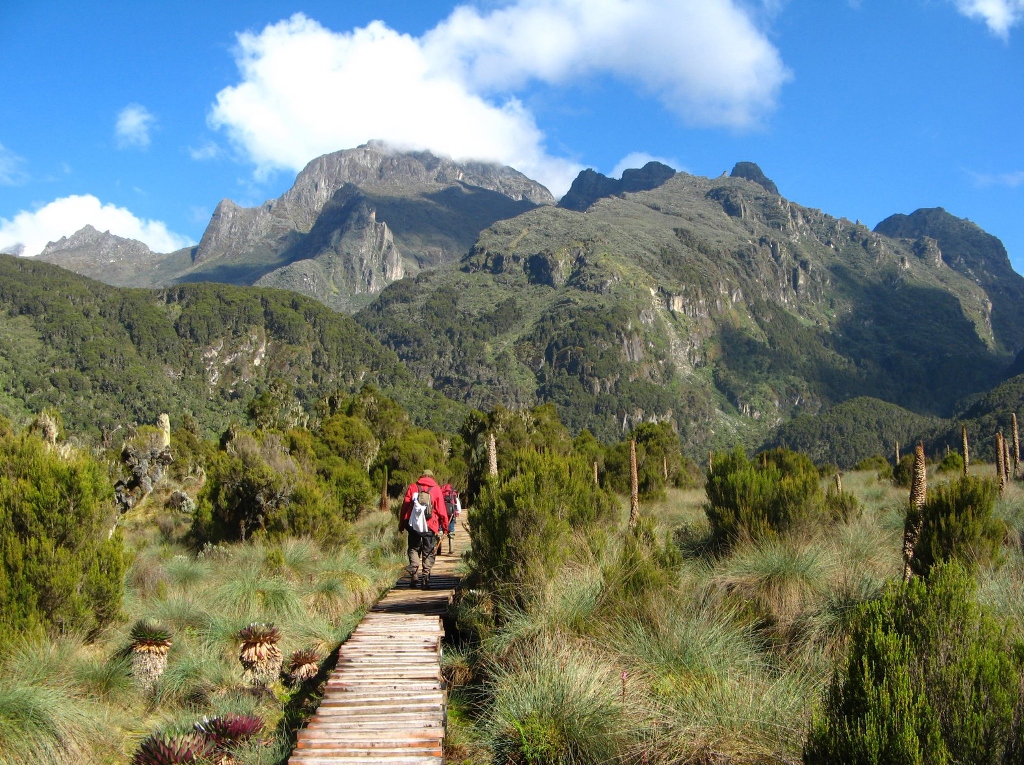What to expect when hiking the Rwenzori Mountains in Uganda: Exploring the Rwenzori mountains of Uganda is one of the nerve-thrilling experiences that the hiker passes through bright fruit forests, montane grasslands, and glaciers. Here’s a detailed guide on what to expect during your trek in this UNESCO World Heritage site:

Brief information about Rwenzori Mountains
Location and Terrain
Location: The Rwenzori Mountains are located in Uganda in the western part of the country near to frontier with Democratic Republic of the Congo.
Altitude: This range is also known as the Virunga Mountains and the highest one in this range is Mount Stanley standing at 5,109m (16,763ft).
Terrain: Despite being located in the geopolitical area of the equatorial world the Rwenzori has features like steep ridges, deep valleys, multiple peaks, glaciers, and snowfields.
Hiking Experience
Routes and Trails
Central Circuit: Of the four routes it is the most favored, and it is normally as long as the route of between 7 and 9 days. It includes: That this circuit offers a fairly good cross-section of Rwenzori’s’ panoramas is by any standard quite impressive.
Margherita Peak: For those who want to get to Mt Stanley, the third and other following days, as well as more of technical climbing, are necessary. It requires more complicated navigation, especially if one has to adapt to the climate of the said area.
Scenery and Wildlife
Scenic Beauty: All that one can imagine is awe-inspiring views of valleys covered in haze, waterfalls, and cliffs towering over the greens. The physical features include; Equatorial rainforests at the feet of the Great Rift Valley and alpine grassland & cliffs at the valley’s crest.
Flora and Fauna: Get to know new plant species such as Lobelia and heather trees as well as some restricted bird species such as the Rwenzori turaco. You should look at any of the primates, including the Rwenzori colobus monkey as well as other species of wildlife that the area is highland.

Preparation Tips
Physical Fitness
Fitness Level: However, hiking in the Rwenzori Mountains is not a task for the weak heart while the muscles of the hiker are also going to be useful in climbing extremely steep slopes and coming down.
Training: Intensify familiarization with increased gradients that replicate the surroundings’ characteristics including inclined planes.
Gear and Essentials
Clothing: Outer base layers should be substances that pick sweat away from the skin, warm base layers including a vest/fleece jacket, warm layer that can be an insulated jacket which can be a down jacket, outer layer which can be a waterproof and windcheater, gloves and headgear.
Footwear: Soccer shoes or good waterproof boots and high-ankle hiking boots should be worn while hiking. Other features such as gaiters to keep the mud and other debris out have most of the time been very useful.
Equipment: Carry along with you a good portable bag, the trekking sticks, extra batteries for your lamp or flashlight, caps/sunglasses, sunscreen lotion, and your medicines / first aid box.
Logistics and Considerations
Permits and Guides
Permits: Namely you can obtain permits from authorized tour companies or Rwenzori Mountains National Park officials. This means that you will have to get permits to go hiking and camping within the park.
Guides: Some of the staff which are compulsory include porters and guides which are recommended in order to safe, direct and inform the visitors about the place. They are aware of steep hills, and sharp turns that characterize trails, weather conditions, and wildlife.
Environmental and Cultural Respect
Leave No Trace: These principles aim at enabling you as an individual to have the least effect on the environment. It means that correlate all litter, respect wildlife, and remain on the paths given in the wild.
Respect Local Communities: This is to inform the cultural and social usages of the local people particularly the Bakonzo who inhabit the Rwenzori region.
Weather and Conditions
Climate: The weather should be expected to vary, and this you will notice by checking the altitude and position of the region, which is almost near the equator of this mountain. Weather conditions include torrential rains most part of the year; therefore, there is a high possibility of encountering slippery trails.
Altitude: Travelers should take some time training their bodies in order to cope with the changes in altitude when they are going on a higher altitude trip. Bear these in mind and do not forget to be slow, drink a lot of water, and try to decipher what your body is telling you.
What to expect when hiking the Rwenzori Mountains in Uganda: Conclusion
Why get that feeling when you can get your adrenalin rush up Rwenzori mountain while in Uganda which has spectacular views and rich biological diversity? If a person prepares himself or herself for it and tries not to be harmful to the environment or the surrounding communities of the areas that the trail passes through, and he or she should approach the trekking experience with lots of enthusiasm and respect then one can accumulate so many things to remember about this wonderful trekking adventure.


